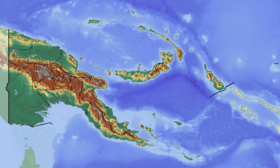Bewani Mountains
| Bewani Mountains | |
|---|---|
 Bewani Mountains | |
| Highest point | |
| Elevation | 1,960 m (6,430 ft) |
| Coordinates | 3°10′00″S 141°15′00″E / 3.1666667°S 141.25°ECoordinates: 3°10′00″S 141°15′00″E / 3.1666667°S 141.25°E |
| Geology | |
| Age of rock | Late Eocene-Early Oligocene |
| Mountain type | Mountain range |
Bewani Mountains is a mountain range in northwestern Papua New Guinea. Together with the Torricelli Mountains and Prince Alexander Mountains it forms the North Coastal Range of Papua New Guinea.[1] Highest point of the mountains is at 1,960 m.
Geology
The Bewani-Torricelli-Prince Alexander Mountains, are presumed to have been formed as an island arc in the Late Eocene-Early Oligocene.[2]
Ecology
As other mountain ranges in Papua New Guinea it is home to many rare species of fauna and flora and is highly biodiverse. The black sicklebill (Epimachus fastuosus) is a threatened species which is known from a few localities in the Bewani and Torricelli mountains.[1] Fiwo, a subspecies of the tenkile (Dendrolagus scottae) tree-kangaroo, is thought to be endemic to the Bewani Mountains.[3] Two frog species described in 2000/2001, Cophixalus bewaniensis and Choerophryne longirostris, are so far only known from the Bewani Mountains.[4][5]
References
- 1 2 Birdlife International: North Papuan mountains, retrieved 11 August 2010
- ↑ P. V. Crowhurst, et al.: Thermochronological and geochemical constraints on the tectonic evolution of northern Papua New Guinea, in Geological Society, London, Special Publications; 1996; v. 106; p. 525-537, retrieved 11 August 2010
- ↑ Tenkile Conservation Alliance, retrieved 11 August 2010
- ↑ Frost, Darrel R. (2014). "Cophixalus bewaniensis Kraus and Allison, 2000". Amphibian Species of the World: an Online Reference. Version 6.0. American Museum of Natural History. Retrieved 4 May 2014.
- ↑ Frost, Darrel R. (2014). "Choerophryne longirostris Kraus and Allison, 2001". Amphibian Species of the World: an Online Reference. Version 6.0. American Museum of Natural History. Retrieved 4 May 2014.
External links
- "Bewani Mountains High Point, Papua New Guinea". Peakbagger.com.